
Transcription
Real Estate Investmentin the USTHE LEGAL PERSPECTIVE
REAL ESTATE INVESTMENT IN THE USIntroductionThe US real estate market remains a preferred optionfor investors seeking diversification and stable yieldsin an uncertain economy, and recent surveys ofcommercial real estate executives show enthusiasticappraisals of the US market’s prospects going forward.That should surprise nobody, given the steadily (if slowly)improving economy and the flood of capital pouring intoproperty markets. Adding to the positive assessment isthe near-unanimous expectation that interest rates willeither remain where they are or increase only slightly.DLA Piper’s Real Estate group in the US is consistentlyrecognized as the country’s leading real estate practice.We offer a full range of services in areas includingacquisitions and disposals, construction, financing,hospitality and leisure, land use, planning anddevelopment, leasing, environmental law, insuranceand tax. We assist clients throughout the entire lifecycle of their investments, and we understand thebusiness of real estate.This document is intended to serve as a comprehensiveguide to the most relevant features of investing in USreal estate, including the process of buying, selling,development, leasing, and financing real property in theUS. This guide does not, however, aim to be exhaustive.The law applicable to real estate differs from stateto state (and in some cases from city to city), so thisguide should not be considered a substitute for thein-depth legal advice that only an attorney, qualified inthe applicable state and well versed in the peculiaritiesof its legal system, can give to their client. If you haveany further questions relating to the material in thisoverview, our experienced US Real Estate team will behappy to assist you.2
WWW.DLAPIPER.COMContents1. OWNERSHIP OF REAL ESTATE047. TAX 141.1 Fee ownership047.1 Real estate transfer tax141.2 Leasehold ownership047.2 Value added tax141.3 Condominium047.3 Property taxes and other taxes141.4 Easements047.4 Taxation of rental income from real estate141.5 Restrictions on ownership by foreigners047.5 Taxation of dividends162. ACQUISITION OF OWNERSHIP057.6 Taxation of capital gains on real estate172.1 Formal requirements052.2 Registration052.3 Asset deals052.4 Share deals06tax act (FIRPTA)192.5 Public auctions077.10 Tax benefits of owning real estate193. CONSTRUCTION 088. REAL ESTATE FINANCE203.1 Contract pricing088.1 Forms of security203.2 Project delivery systems088.2 Creating and perfecting security203.3 Risk allocation and dispute resolution098.3 Enforcement204. ZONING AND PLANNING LAW PERMITS108.4 Borrower insolvency/priority of liens205. ENVIRONMENTAL LIABILITY117.7 Taxation of gain on disposal of partnershipinterest in a partnership owning real estate7.8 Real estate investment trusts (REIT)17177.9 Foreign investment in real propertyCONTACTS 21ABOUT DLA PIPER 236. LEASES 126.1 Duration126.2 Rent126.3 Operating expenses126.4 Maintenance and repair136.5 Assignments, subleases and mortgagingleasehold interests136.6 Insurance136.7 Termination136.8 Requirements for writing133
REAL ESTATE INVESTMENT IN THE US1. Ownership of real estate1.1 Fee ownership1.4 EasementsFee ownership is the highestA real estate owner can also giveSeptember 2001, the federalcategory of ownership in the US,non-exclusive rights, known asgovernment has regulatedgiving the owner rights to possesseasements, to third parties to useinvestment in the US throughand dispose of land. Fee ownershipthe land, such as granting a rightdisclosure and other lawsincludes ownership of all constituentof way. Recorded easements aredesigned to identify terroristparts of the property, buildings,binding on any successors in title toorganizations and individuals,and everything above andthe property. State laws regardingunder a statutory scheme knownbeneath the surface of the landeasements vary.as the Patriot Act. Prospectivesuch as underground structures,unless rights thereto have beengranted to a third party.1.2 Leaseholdownership1.5 Restrictionson ownership byforeignersThere are no blanket prohibitions onforeign ownership of US real estate,Ownership of a leasehold interestbut various US laws imposeconfers rights of exclusiverestrictions and requirementspossession and use of land for aapplicable to foreign investors inlimited period of time, subject to thecertain cases, including:terms of the lease. Most commercialtransactions for acquisition of Foreign Assets Control Rules: The Patriot Act: Sincebuyers may be required tomake certain disclosures underthese laws. BEA Reporting Requirements:Foreign investment in a USbusiness which results in a foreignperson or entity owning 10% ormore of the voting securities ofa US business may be subjectto reporting requirementsadministered by the Bureau ofEconomic Analysis (BEA) of theproperty involve fee interests, butThe federal government imposestransactions can also be structuredeconomic sanctions againstas a long-term ground lease. In suchand prohibits certain dealsThe foregoing are not the onlycase, at the end of the lease termwith various countries, entities,US laws that impact ownershipownership of improvements on theindividuals and organizations.by foreigners. Non-US investorsproperty would typically revert to theThe Office of Foreign Assetsshould also keep in mind: (i) thelandlord. As noted below, consentControl at the US Department ofForeign Investment in Real Propertyof the landlord may be required forthe Treasury (OFAC) administersTax Act (FIRPTA), discussed intransfer of a leasehold interest inand enforces these sanctions, andsection 7.9 below, (ii) regulationsreal property. Leases are discussedall US Persons (i.e., US citizens,passed by the Department ofin section 6 below.permanent resident aliens,Defense (e.g. International Trafficpersons and entities within thein Arms Regulations), (iii) theUS, and all US-incorporatedAgricultural Foreign InvestmentCondominium ownership allowsentities and their foreignDisclosure Act of 1978, (iv) thefee ownership of a self-containedbranches) are required to complyHart-Scott-Rodino Antitrustunit within a building togetherwith the sanctions.Improvement Act of 1976 and1.3 Condominiumwith non-exclusive rights (withother condominium unit owners)to certain common areas of theproperty. Although most oftenused in the context of multi-unitresidential properties, commercialcondominiums are becoming morecommon. State laws regardingcondominiums vary.4 CFIUS: The Committee on ForeignInvestment in the US (CFIUS)oversees enforcement of laws thatallow certain foreign investmenttransactions to be blocked wherethey might impact US nationalsecurity, and can cause divestitureof completed investments incertain circumstances.US Department of Commerce.other antitrust and competitionlaws, (v) export control rules andregulations, (vi) US antidumpingand countervailing duty laws,(vii) US immigration laws, (viii) taxlaws, and (ix) state and local laws.
WWW.DLAPIPER.COM2. Acquisition of ownership2.1 Formalrequirementsof residential tenants upon asatisfy itself regarding propertytransfer of title by their landlord.condition, title, and other matters.Transfer of real property is typicallyIn addition, federal laws maySeller’s warranties are generallyaccomplished pursuant to the termsbe applicable.not provided under statute and theof a purchase and sale contract thatseller and buyer will negotiate theis negotiated and executed between2.2 Registrationparties after they have reachedAs noted above, fee ownership isand warranties when negotiatingagreement on the purchase pricegenerally transferred by a deedthe purchase agreement. Theand other fundamental terms of acomplying with the requirementsagreement will also usually providetransaction. The purchase and saleof applicable state law. The deed, infor the extent of remedies availablecontract, to be enforceable, mustorder to provide constructive noticeto the buyer if the seller makes abe in writing, signed by the parties,to future prospective purchasersmisrepresentation. In most cases,and must identify the property toand other parties that title to thethe buyer’s remedy will be limited tobe sold and the material terms ofproperty has been transferred, musttermination of the agreement andthe transaction. Applicable state lawbe recorded in the proper registryobtaining a refund of its deposit ifwill mandate any further particularor recording office. There is nothe misrepresentation is discoveredrequirements for the contract, whichsingle property register or recordingprior to closing and, if discoveredmay otherwise be negotiated freelyoffice for all properties in the US.after closing, to monetary damagesbetween the parties.Each county within each statewhich may be limited in amountmaintains its own property records.and otherwise by the terms of theThere will usually be an intervalextent of any seller’s representationsagreement. It is typical for anybetween the date of the purchase2.3 Asset dealsand sale contract and the date whenThe most common form of realclaims to be subject to a survivalthe title transfer takes place, whichestate transaction is an asset dealperiod, after which a buyer maytransfer is referred to as the closing.in which the buyer acquires a feehave no remedies against a seller.The actual conveyance of ownershipsimple ownership interest in a givenat closing is usually completedparcel or parcels of real property.In many but not all localities in thesimultaneously with payment of theAs noted above, asset transactionsUS it is customary for a buyer topurchase price, and is accomplishedare typically completed pursuantbe entitled to an initial period afterthrough execution and delivery of ato the terms of a purchase andsigning of the contract, known asnotarized deed complying with thesale contract that will describea due diligence period, in whichrequirements of applicable state law.terms of the transaction. Theseto conduct investigations of theshould include purchase price, anyproperty and during which theThere is not one single set of USdeposit, any due diligence period,buyer may withdraw from thelaws governing the transfer ofa mechanism for the buyer totransaction and the buyer’s deposittitle to real property. Each stateinvestigate title, the representationsmay be subject to refund. Thehas its own law, consisting of caseand warranties given regardingcontract should specify the lengthlaw and statutes, applicable to thethe property, the closing date,of any due diligence period (usuallyacquisition of interests in land; localdocuments to be delivered atin the range of 30 to 90 days)regulations are also applicable toclosing, the allocation of propertyand the scope of documents andaspects of property ownership,costs and income at closing, andinformation that must be providedsuch as zoning compliance andother matters such as the allocationby the seller to the buyer before orbuilding codes, and state laws mayof risk if the property is damagedduring this period. If the contractalso be targeted at specific classesprior to closing.does not provide for a due diligenceof property. For instance, specialpost-closing misrepresentationperiod, the buyer should conduct itsenvironmental disclosure lawsGenerally, the rule of caveatdue diligence investigations prior toapply in some states with respectemptor (i.e. buyer beware) appliessigning the contract.to certain categories of industrialto most real estate purchase andproperty and some states imposesale transactions, under whichprotections for the security depositsit is a buyer’s responsibility to5
REAL ESTATE INVESTMENT IN THE USAs part of its due diligenceused in compliance with any localmany localities transfer taxes are low,investigations, the buyer will (withpermits and land use restrictions,and in some localities there are nothe aid of its counsel) typicallyincluding any certificate of occupancytransfer taxes.review a title report preparedissued by the applicable localby a title insurance company,governmental authority and thatLocal customs for allocation ofunderlying title documents, athe property is not subject to anyclosing costs vary, including withsurvey, searches respecting thenotices of violation issued by anyrespect to which party is generallyseller, certificates of occupancysuch authority. The responsibilityresponsible for escrow fees,and permits, any environmentalof property owners for priortitle insurance and survey costs,reports and physical conditionenvironmental contamination isrecording charges, and city, countyreports, contracts affecting thegoverned both by federal law andand state transfer taxes. Localproperty, leases, any zoning reports,by the state law of the property incustom can be modified by contract,insurance certificates, appraisals,question, as discussed below.and the purchase agreement shouldand financial documents. The deedcomprehensively describe how costsmay include representations byIn order to ascertain the permittedare to be allocated between thethe seller concerning title, but suchuses of a parcel of real estate underparties.representations are often limited.the applicable zoning or planningPurchasers of fee ownership inlaw, a buyer will typically request2.4 Share dealsland typically obtain an owner’sthat the seller deliver a copy of theAnother way to acquire real estatetitle insurance policy effective atcertificate of occupancy confirmingis for a buyer to purchase the legalthe closing that protects againstthe permitted use or the title insurerentity which owns the property,undisclosed liens, encumbrances,will obtain a copy of the certificatethrough a transfer of ownershipand title defects. Terms of thefrom the municipality. In someinterests in such entity rather thancoverage and endorsements tolocalities, certificates of occupancythe sale of the assets owned by theincrease coverage may be negotiatedare not issued. In either case, it isentity. In the US, the legal entitiesin most jurisdictions.also common for a zoning report tothat own real property come inbe obtained to confirm the permittedvarious forms, but the most commonIn connection with a sale transaction,use, and if the buyer is planningare limited liability companies andconsent is typically required fromto change the use or to performlimited partnerships.anyone who has lent money to theconstruction at the property, furtherseller and has a security interest ininvestigation of the zoning regimeWhen a transaction is structured asthe property being sold, unless theapplicable to the property should bean entity or share deal (i.e. a transfermortgage is being paid off in full,undertaken as part of due diligenceof entity ownership interests),in accordance with its terms, at theinvestigations.different tax considerations mayapply. The applicability of taxes andclosing (which is, in fact, the mostcommon scenario). The holders ofAsset deals are subject to a range oftransaction costs to an entity orany rights of first offer or first refusaltaxes and other transaction costs, asshare deal, and local custom as toaffecting the property will have todiscussed further in section 7 below.the allocation of those costs betweenwaive or fail to exercise their rights.Depending on where the propertythe buyer and the seller, varies fromConsent may also be required fromis located and other factors, thesestate to state. State and other localthe landlord if the land interestcan include city, county and statelaws of the property in question willbeing sold is a leasehold interest.transfer taxes, mortgage recordingdetermine whether transfer taxesState law will mandate whether anytaxes, sales taxes and brokerageand other taxes are payable in aspecial consents are required fromfees. The types and rates of taxesshare deal. In most instances, theoccupants of residential propertyvary depending on locality, propertyapplicable state, or the county inthat is being transferred.type and purchase price, and therewhich the property is situated, hasmay be city, county and state transferestablished customs for mattersZoning, construction andtaxes applicable to an asset sale, assuch as allocation of escrow fees,environmental laws may all applywell as separate mortgage recordingtitle insurance and survey costs, andand should be investigated with thetaxes and in some cases othercity, county and state transfer taxes,assistance of counsel. As part of itssupplemental transfer-related taxes.but these customs can be varieddue diligence, the buyer will wish toHowever, in most other states noby contractconfirm that the property is beingmortgage recording tax is payable, in6
WWW.DLAPIPER.COMand the purchase agreement for(i) all legal aspects of the shares or2.5 Public auctionsthe transaction should describe theother ownership interests in theFor specialist investors, purchasingallocation of those costs betweenentity owning the property such asat a public auction can bethe parties in detail.whether there are any pre-emptionconsidered. Properties for sale byrights, encumbrances, etc.;auction are usually the subject ofThe due diligence prior to closingan enforced sale, such as a saleof a share deal should, in addition(ii) whether the entity has (or haspursuant to a court order arisingto the due diligence referenced inpreviously had) employees, and thefrom a bankruptcy or foreclosureparagraph 2.3 above concerning theliabilities in relation thereto; andby a secured lender. The complexityunderlying real property itself, coverof the auction procedure makes itthe entity at issue, including with(iii) all other pre-existing assetsadvisable for a prospective buyerrespect to:and liabilities of the entity,to work closely with legal advisors,including under any prior orincluding as applicable qualifiedexisting contracts, and under anybankruptcy specialists.applicable laws.7
REAL ESTATE INVESTMENT IN THE US3. Construction3.1 Contract pricingplus a pre-negotiated fee up toDesign/Bid/Build: this is the mostConstruction projects can be priceda cap or GMP. Absent a formaltraditional delivery method in USin a number of different ways to suitchange order, the contractor isconstruction. Under this system, thethe individual needs of a particularliable for costs that exceed theowner contracts with the architectproject. Commonly used pricingGMP. When the actual cost of thefor the design and then uses thatarrangements include the following:project is less than the GMP, thedesign to secure competitiveowner and general contractor oftenbids and ultimately enter into anLump Sum: under a lump sumshare the savings. Guaranteedagreement with a contractor foragreement, the contractor agreesmaximum price contracts are thethe construction of the project.to perform the work for a fixedmost common pricing arrangementThis method is easy to manageprice. This arrangement is bestfor large commercial projects andand provides a clear separationsuited for projects where the scopehave the advantage of providingof design and constructionof work and schedule are detailedthe owner with the assurance thatresponsibility. However, the rigidenough to allow the contractor towill not be liable for cost overruns.separation of these functions canaccurately estimate the cost of theHowever, it is common for there toresult in inefficiencies and create anproject. Lump Sum projects give thebe disagreements between ownersadversarial relationship between theowner the advantage of being ableand contractors about what is in thecontractor and the architect.to limit exposure for cost overruns;GMP and contractors may providehowever, the owner will not be ableinflated estimates to limit theirDesign-Build: under a design-buildto capture savings, if the actualexposure for cost overruns.contract, the owner contracts withcost of the project is less than thea single entity for both the designTime and Materials: under aand construction of the project.time and materials contract, theThis method endeavors to createCost Plus: under a cost plusowner agrees to compensatea streamlined process where thecontract, the owner pays thethe contractor for work basedowner has a single point-of-contactcontractor the actual cost of theon a pre-negotiated unit priceand design and construction can bework plus a pre-negotiated fee. Thisschedule. This arrangement isdeveloped concurrently. However,is most common where the ownermost appropriate where the ownerhaving only one firm responsiblewants to include the contractorcan accurately identify the workfor both functions can result in lessduring pre-construction and therethat needs to be done but may beowner control and the elimination ofare uncertainties about the finaluncertain of the specific quantities.the checks and balances that exist inscope of work. Cost plus contractsThis arrangement is often used formore-traditional delivery methods.promote efficiency by involvingrepetitive, easily quantifiable tasksthe contractor in early stages ofand is not typically used for complexCM At-Risk: CM at-risk projectsthe project; however, financialconstruction projects.consist of a three-party teamlump sum price.considerations are a concernincluding the owner, architect,incentive to limit costs because they3.2 Project deliverysystemsare not subject to a cap and willThere are a number of differentconstruction manager are underreceive fee on additional costs.methods for assigning responsibilityseparate contracts; however, herefor the design and constructionthe construction manager is typicallyGuaranteed Maximum Price:of a project and the projectengaged during the design phase toin a guaranteed maximum pricedelivery system should accountconsult during preconstruction. Thecontract, the owner pays thefor the specific budgetary, quality,construction manager is consideredcontractor the cost of the workand scheduling needs of eachto be at risk because it operates asindividual project.a general contractor and assumesas contractors may not have anand a construction manager. Likeother methods, the architect andscope and schedule responsibilityfor construction once the designis completed.8
WWW.DLAPIPER.COMIntegrated Project Delivery (IPD):include indemnification provisions,Dispute Resolution: constructionthis method has been developedwarranties, schedule-relateddisputes are generally heard inin an attempt to respond to therequirements (including thestate and federal courts in thecomplexities of modern constructionimposition of liquidated damages),state where the project is located.by creating a team of projectand the ability to withhold payment.In lieu of litigation, parties mayparticipants that is engaged early inmutually agree to arbitrate theirthe project to develop an approachWith respect to insurance, each partydispute. Although not always thethat identifies and addressesto a design or construction contractcase, arbitration is intended topotential project issues. IPD strivesshould always confer and obtainbe an informal and more-efficientfor the sharing of risk through theadvice from its own risk manager orprocess than litigation. However,integration of resources, processes,insurance agent regarding the typesarbitrator decisions are final andand expertise; however, absentand limits of insurance that will bestare only subject to appeal underexceptional circumstances, it canprotect each project.extremely narrow circumstances.be difficult to implement withThere are many factors thatactors that are accustomed to moreIn addition, owners may seekdetermine whether a party shouldtraditional methods.additional security from apursue litigation or arbitration andthird-party surety or a guaranteeeach matter should be consideredfrom a contractor’s parent company.on a case-by-case basis. In addition,Common forms of bonds thatparties often engage in mediationRisk Allocation: in addition toprotect various parties to thein an attempt to resolve the matterproject delivery systems and pricingconstruction process includeearly on in the dispute. This isarrangements, construction riskperformance bonds wherein theoften non-binding and done at thecan be managed through a numbersurety guarantees to the owneragreement of the parties.of different vehicles, includingthat the contractor will completethe use of specific contractualthe construction work and paymentprovisions, insurance, and bonds/bonds that guarantee to the ownerguarantees. Common contractualthat the contractor will pay itsclauses used to distribute risksubcontractors and suppliers.3.3 Risk allocation anddispute resolution9
REAL ESTATE INVESTMENT IN THE US4. Zoning and planning law permitsZoning and planning law permitsbuilding department officials forapplicant (and, in some cases, byin the US are governed primarilycompliance with local buildingothers) to a local appeals board or aat the local level by municipal andstandards and local zoning andcourt for resolution.county governments. Authority forsubdivision ordinances. Consentsuch local governance is derivedfrom regional and state agenciesDepending on the proposedfrom and defined by applicablemay also be required. In someproject, additional agreements withstate law, and can vary significantlycases, design and appearance ofgovernmental authorities may alsoin both substance and procedure.new buildings also requires approvalbe needed. Types and forms ofApplicable laws are typicallyfrom local authorities.agreements depend upon particularlocal practice and applicablecontained in local comprehensiveplanning documents and localPermitting approval timelines varyzoning and subdivision ordinances.significantly, depending on variousstate law.factors. New development approvalsViolations of local zoning andDevelopment must be in accordanceoften require formal hearings atplanning requirements can resultwith use restrictions and in mostwhich members of the public canin governmental imposition ofcases a use must be permittedtestify for or against a proposedfines and/or injunctions requiringin the district where the propertyproject. Local reviewing bodies willspecific actions be taken. In someis located or specific approval ofoften require extensive applicationjurisdictions, third parties canthe use must be obtained. Evenmaterials, and will issue findings ofseek to enforce zoning ordinancesif the use at issue is permitted,fact respecting a proposal.through legal action.approval is sometimes required fora change of use.Depending on the proposal, finaldecisions may be made by planningPlans for new construction andstaff, a local reviewing body, ormost refurbishment must typicallyelected officials. Appeals of adversebe reviewed and approved by localdecisions may be submitted by the10
WWW.DLAPIPER.COM5. Environmental liabilityThere are a number of complexmaterials at a site, the kinds ofamounts recovered frequently failproblems that can arise frommaterials used in construction,to make the subsequent ownerthe laws and policies governingpollution prevention, providing forwhole. Therefore, buyers often relyenvironmental issues in real estatestorm water and drainage, andupon contractual protections (suchtransactions, and non-compliancesustainability guidelines.as indemnification provisions) towith regulatory requirements andprovide certainty and redistributethe failure to address potentialUnder a wide range of federal,environmental risk. However,liabilities can carry significantstate, and local regulations, thein order to effectively allocatefinancial risk.owner of real property can becontractual liability, parties mustheld liable for the entire cost ofobtain a thorough understandingThe US Environmental Protectionremediating environmental hazardsof existing conditions at a site byAgency (EPA) is charged with theon a property that it acquires,conducting extensive environmentalprotection of the environmentregardless of whether it contributeddue diligence prior to acquiringand has promulgated manyto the contamination or otherany real property interest. Oncerequirements and protectionsenvironmental damage at theexisting risks are known, partiesgoverning the allocation ofsite. Although the owner may becan negotiate for the appropriateresponsibility for environmentalable to pursue previous owners tocontractual protections.issues. To name just a few,recover costs incurred to remediateregulations include those thatenvironmental issues at a projectgovern the discovery, handling,in most jurisdictions, adversarialand remediation of hazardousproceedings are often uncertain and11
REAL ESTATE INVESTMENT IN THE US6. LeasesThere are two main types of6.1 Duration6.3 Operating expensesarrangements allowing a person,The duration of commercial leasesLeases of premises withincompany or other organizationvary but, in many instances rangemulti-tenanted properties generallyto occupy real estate for a limitedfrom three to ten years. Leasesprovide an operating expenseperiod of time without buyingof over 30 years tend only to beclause detailing a mechanism forit outright.ground leases and net leases.the tenants to proportionatelyshare the cost of maintaining andThe first is a lease, which grantsGenerally, a tenant’s right to occupyoperating the common facilities.the right of exclusive possession ofthe leased premises ends when theMany leases require tenants only tothe property for an agreed periodlease term expires. However, underpay increases above those operatingof time. A lease confers on thethe common law holdover rule, aexpenses that the landlord incurredtenant contractual rights and atenant remaining in possessionin a set Base Year.proprietary interest in the property.after lease expiration withoutThere are different types of leasesthe landlord’s agreement may beTenants of multi-tenantedbut commercial leases broadly falltreated by the landlord either as aproperties will typically be chargedinto one of two categories: Grosstrespasser subject to eviction or as afor electricity either directly byLeases where the tenant’s financialtenant under a lease
7.4 Taxation of rental income from real estate 14 7.5 Taxation of dividends 16 7.6 Taxation of capital gains on real estate 17 7.7 Taxation of gain on disposal of partnership interest in a partnership owning real estate 17 7.8 Real estate investment trusts (REIT) 17 7.9 Foreign investment in real property tax act (FIRPTA9 1 )










